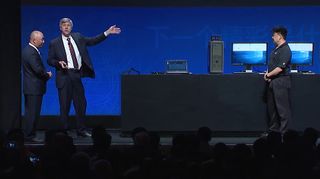Intel Shows Optane (3D XPoint) In A Backup Device At IDF Shenzhen
Rob Crooke, Intel VP for Non-Volatile Memory Solutions Group (NSG), joined Ian Yang, President of Intel China, on stage to talk about Optane technology and perform the first public demonstration. Optane, also known as 3D XPoint, promises DRAM-like performance with flash-like data storage retention. Once implemented, Optane will turn your computer into an instant booting device like a tablet or cell phone. The technology will also increase random performance by a significant amount--some speculate up to 10 times performance increase with small block sizes.
This will increase the user experience to levels we cannot even imagine possible, yet. This is the most exciting memory product to come to market in over twenty years, and it promises to change computing as we know it.

To show the awesome power of 3D XPoint, Intel chose to demonstrate sequential performance over Thunderbolt 3. The world's most powerful (and potentially expensive) persistent memory was reduced to a consumer backup device for its first working public demonstration.

In the test, Intel used two computer systems. The first system utilized two Intel SATA SSDs to transfer a movie from the host machine to a Thunderbolt 3-connected device using another Intel SATA SSD. The transfer performance clearly shows a TLC-based SATA device--most likely the company's new SSD 540 or 5400 Series business-class drive. The second computer transferred the same movie file over Thunderbolt 3, but this time the host and destination media were based on Optane memory technology.
On the surface, the 2 GB/s transfer was impressive. The performance was consistent and didn't take much time. Upon closer inspection, though, this was the worst possible demonstration of Optane technology Intel could have shown. The company's own SSD 750 Series could have produced similar results.
The demonstration the world is waiting on involves random performance; it's the one area Optane changes storage for consumers. We won't see Optane technology in a data backup device for a decade or more, but a small amount of Optane to cache TLC NAND will go a long way in improving the user experience. If Intel doesn't arrange a public demonstration, we will have to wait until the second half of 2017 when we get our own Optane devices to run the tests ourselves.
At IDF 2015 in San Francisco Intel displayed a static image of Optane reading random data at 76,000 IOPS using queue depth 1. That is a full 7x improvement over the company's current NVMe-based consumer SSDs.
Stay on the Cutting Edge
Join the experts who read Tom's Hardware for the inside track on enthusiast PC tech news — and have for over 25 years. We'll send breaking news and in-depth reviews of CPUs, GPUs, AI, maker hardware and more straight to your inbox.
You can watch the full IDF 2016 keynote from Shenzhen, China here.
-
Mac266 Mobile phones aren't instant booting. They do instantly wake, but that's only because the device is still active with the screen turned off. That line makes very little sense.Reply -
nukemaster Reply
I was thinking the same thing. I mean phones are actually not that fast to start from fully off.17818989 said:Mobile phones aren't instant booting. They do instantly wake, but that's only because the device is still active with the screen turned off. That line makes very little sense. -
CRamseyer People associate instant-on devices with phone and tablets. In this case it is literally the thought that counts.Reply -
JQB45 I've never thought of a tablet of smart phone as being instant booting, either. From fully off to ready to use takes a decent amount of time.Reply -
Mac266 As a comparison, I can turn my monitor off when I'm not using it, and then on when I want to use it. Like a phone, storage speed has very little to do with screen activation.Reply -
epobirs Seems like this was more of a demonstration of Thunderbolt 3 than Optane since they could have gotten the same effect going between two PCIe x4 M.2 SSDs.Reply
When testing USB 3.1 the only way I could see the full read performance was to have a Samsung 950 as the destination. Otherwise the write speed of the destination would have been a bottleneck. I suppose I could have tested doing a copy from the USB 3.1 SSD to a RAM disk but that didn't seem like a very real world situation. -
rantoc Almost makes me wonder if they had alternative motives - like hiding yet to hammer out low random access times - for doing it this "lame" way...Reply -
hannibal When we can not see products for long time it is quite normal to show only "minor" stuff at this moment. The sales of today devices would blum...Reply
Most Popular





